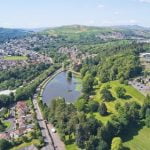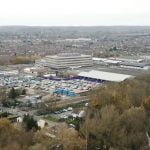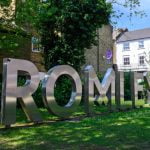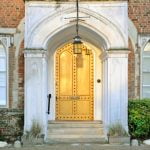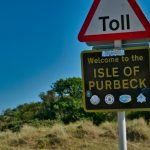A quick guide to the Borough of Croydon
Overview
The London Borough of Croydon is situated is the southmost of outer London and covers an area of 87 km2. The borough was formed in 1965 from the merger of Coulsdon and Purley Urban Districts and the County Borough of Croydon. The historic town of Croydon from which the borough takes its name is both its geographical and administrative centre. While the Borough of Croydon is mostly urban, there are large suburban and rural uplands towards its south boundary. The borough borders the borough of Bromley to the north and east, and boroughs of Lambeth and Southwark, to the north-west. The boroughs of Sutton and Merton are located directly to the west. At the 2011 UK Census, the population of the borough was recorded as 363,378.
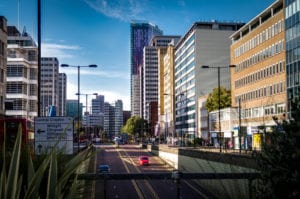
Street view of Wellesley Road (A212), East Croydon
A Very Brief History
Archaeological evidence suggests the Croydon area has been inhabited since at least the Iron Age. However, it was the 8th-century Anglo-Saxons who were the first known permanent settlers of the area. The name Croydon stems from the Old English word of ‘Crogdene’ or ‘Croindone’. The name is thought to derive from the Anglo-Saxon ‘croeas deanas’, meaning “the valley of the crocuses”, indicating that it was probably a centre for the collection of saffron.
The Manor of Croydon was connected with the Archbishop of Canterbury from at least the late Saxon period, and records of buildings date back to at least 960. Croydon is mentioned in William the Conqueror’s Domesday Book of 1086, where it was recorded that it had a church, a mill and around 365 inhabitants. The 11th-century Archbishop of Canterbury, Lanfranc made his summer home at the local manor house, which still stands today.
In 1276, Archbishop Robert Kilwardby acquired a charter for a weekly market, which was the foundation from which the town of Croydon developed as an urban centre. The market place was laid out on the high ground to the east of the manor house in the triangle now bounded by High Street, Surrey Street and Crown Hill. By the 16th century, the manor house had become a substantial palace and was still used as the main summer home of the archbishops of Canterbury. Highly esteemed visitors included Henry VIII and Elizabeth I, as well as Thomas Becket. Croydon Palace as it now exists is now largely an eclectic mix of 15th and 16th-century buildings, known as the ‘old palace’ and serves as a private school.
Croydon, the main urban centre of the Borough, prospered through the ages as a market town. Some of its chief products were charcoal, leather and beer. In 1803, Croydon saw the opening of the world’s first public railway, the Surrey Iron Railway. The horse-drawn 9-mile route ran to Wandsworth. By the mid-19th century, Croydon had become a stop on the London to Brighton rail link, which helped it to become the largest town in what was then Surrey.
In the early 20th century, Croydon became known for the production of metalwork and car manufacture, as well as its famed aerodrome, Croydon Airport. Starting out during WWI as an airfield to protect against Zeppelins, it was eventually enlarged and re-opened on 29 March 1920 as a commercial enterprise. It became the largest such facility in London and the main terminal for international air freight. During the 1920s and 1930s, it developed into one of the great airports of the world. However, the presence of the airport made Croydon a stand-out target during WW II, meaning the area was heavily bombed by the Luftwaffe. By the early 1950s, as aviation technology rapidly progressed, with aircraft becoming larger and flights more numerous, it was recognised that the airport would be unsustainable due to the localised constraints. New main airports were built at Heathrow and Gatwick, whilst the last scheduled flight from Croydon Airport, departed on 30 September 1959. The restored air terminal is now known as ‘Airport House’ and houses a hotel and museum.
From the late 1950s onwards, through to the late 1960s, Croydon town centre underwent massive redevelopment. Large numbers of office blocks were built, as well as the Whitgift Centre, which at the time was recognised as the biggest shopping centre in Europe. However, Croydon had even bigger ambitions, as in 1954, and then again in 2000, 2002 and 2012, Croydon Borough Council applied unsuccessfully for ‘city’ status as it vied to become Greater London’s third area, along with the City of London and the City of Westminster, to be given the prestigious title. The applications have all been refused for the same basic reason, which is that it was felt that Croydon does not have an identity separate from that of the rest of Greater London.
However, Croydon’s transformation remains incomplete as it is currently undergoing yet another rigorous urban regeneration plan, which has been named ‘Croydon Vision 2020’. One of the main aims of the plan is to achieve the coveted ‘city’ status and become a hub for retail, business and culture in South London and South East England. The plan which was showcased at the ‘Croydon Expo’, involves £3.5bn worth of development, which the Council hopes to implement over the next 10 years.
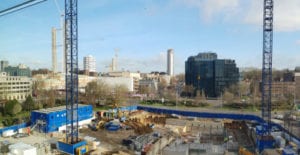
Croydon is currently undergoing major redevelopment
Famous People
Some of the famous people who were born or have lived in the Borough of Croydon are:
- Dame Peggy Ashcroft (1907–1991), world-renowned actress, born in Croydon, lived in George Street as a child
- Raymond Chandler (1888–1959), the American detective fiction writer, lived in Upper Norwood as a schoolboy
- Sir Arthur Conan Doyle (1859–1930), Scottish-born fiction writer, famously created Sherlock Holmes
- D.H. Lawrence (1885–1930), famed novelist, lived at in Colworth Road, Addiscombe between 1908–1912
- David Lean (1908–1991), world-renowned film director, producer and screenwriter, known for his ‘epic’ films, was born in Croydon
- Kate Moss (1974–), supermodel, attended Riddlesdown High School
- Amy Winehouse (1983–2011), the precocious talented singer attended the BRIT School
Getting Around!
As with the rest of London, the trains are a quick and convenient method of getting around in Croydon. However, unlike most of the rest of the capital, Croydon also has tram service. Buses generally work out cheapest but might prove to be the best mode of transport for getting across the city.
Road
A few miles to the south of Croydon is a small gap in the North Downs, a route for transport from London to the south coast. The London to Brighton road used to pass through the town on North End before the A23 Purley Way was built to the west. Transport for London operates many bus routes in and around Croydon. Most buses operate out of West Croydon bus station, which is situated next to the railway station and tram stop.
London Trams
Tramlink is a tram system operated by London Trams which has Croydon at its hub. The current network consists of two lines, which run from Elmers End/Beckenham to Wimbledon and from New Addington to West Croydon, with all trams passing through central Croydon. There are current plans underfoot to expand the Tramlink network to other parts of London. Tram stops are located approximately every kilometre along the routes. Those that lie in the Borough of Croydon are listed below.
Tramlink Stops
- Addington Village
- Addiscombe
- Ampere Way
- Arena
- Beddington Lane
- Blackhorse Lane
- Centrale
- Church Street
- Coombe Lane
- Fieldway
- George Street
- Gravel Hill
- Harrington Road
- King Henry’s Drive
- Lebanon Road
- Lloyd Park
- New Addington
- Reeves Corner
- Sandilands
- Therapia Lane
- Waddon Marsh
- Wandle Park
- Wellesley Road
- Woodside
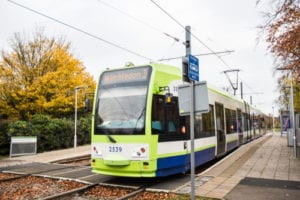
Londons Trams operate a tram service throughout Croydon
Rail
Croydon is served by East Croydon and West Croydon stations. East Croydon is served by Govia Thameslink Railway, which is operated by Southern and Thameslink on the Brighton Main Line. West Croydon is served by the London Overground and Southern services.
National Railway Stations
- Coulsdon South
- Coulsdon Town
- Kenley
- Norbury
- Norwood Junction
- Purley Oaks
- Purley
- Reedham
- Riddlesdown
- Sanderstead
- Selhurst
- South Croydon
- Thornton Heath
- Waddon
London Overground Stations
- East Croydon
- West Croydon
Things to see and do!
Parks and open spaces
- Wandle Park – Venue offering kids’ playgrounds, ornamental gardens, a skate park & various cultural events
- South Norwood Country Park – Large park with meadows, wetlands & lake, bike path, playground & pitch-&-putt golf
- Crystal Palace Park – Large green space with dinosaur trail from the Victorian era
- Mitcham Common – Large park with open grassy space, wooded areas & ponds
- Beddington Park & The Grange – Parkland set around a historic Tudor country house
- Lloyd Park – Public green space with a pond, woods, a bowling green, football pitches, cafe and kids’ playground
- Addington Park – Park and garden that covers an area of 24.5 acres.
- Hutchinson’s Bank – 21.8 hectare Local Nature Reserve and Site of Metropolitan Importance for Nature Conservation
- Grangewood Park – Day-use green space with mature trees & gardens, plus tennis courts, a pavilion & a playground.
- Wandle Trail – 12.5-mile walking and cycling trail that follows the River Wandle from Croydon to Wandsworth Former Croydon Union Workhouse
- Riddlesdown – Greenspace for walks & natural scenery
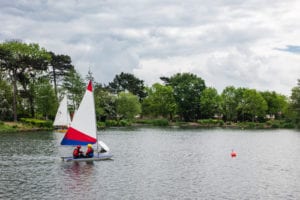
A typical view of South Norwood Country Park
Tourist attractions
- Selhurst Park Stadium – Home ground of Crystal Palace Football Club who play in the English Premier League
- Croydon Airport Visitor Centre – Small museum in a historic air traffic control tower featuring aviation models & displays.
- Croydon Clocktower – Complex with museum, cinema & library
- Church of St. John the Baptist – Large middle Saxon C of E church
- Croydon Palace – Former summer residence of the Archbishops of Canterbury for over 500 years
- Honeywood Museum – Regional museum with adjacent tranquil pond
Crystal Palace FC
Crystal Palace Football Club is a well-established team that plays in the English Premier League. They play their home games at Selhurst Park in Selhurst, Croydon. The games normally take place every other Saturday between August and May. The ground is just a 10-minute walk from either Selhurst or Norwood Junction stations. It’s possible to take an organised tour of the ground.
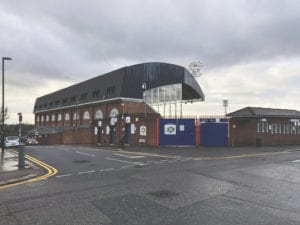
Street view of Selhurst Park, home Crystal Palace
Did you know?
- Croydon was home to the UK’s first international airport
- Croydon has aspirations to become an independent ‘city’ which it has already attempted on 4 previous occasions
- Henry VIII often stayed in Croydon to court his first wife, Catharine of Aragon
- Due to long historic connections, many former Archbishops of Canterbury, are buried in Croydon
Where to stay?
There is very little in hostel-style accommodation if you actually want to stay in Croydon. However, there’s plenty of B & B/Guesthouse/Basic Hotels style accommodation on offer. If you’re looking for a bit more luxury then there’s also plenty 3, 4 and 5-star hotel style accommodation on offer. Accommodation costs are generally quite favourable when compared to most of the rest of London. An alternative to a hotel would be to rent an apartment – most have no minimum let period. While the majority of apartments cater to couples, some can accommodate up to 6 people. Indicative prices for the most readily available types of accommodation/per night, based on 2 adults sharing, unless otherwise indicated, are as follows:
B & B/Guesthouse/Basic Hotel: £45 – £90
3/4 Star Hotel: £90 – £200
Apartments vary greatly based on no. of available berths, location and standard
If you enjoyed this London guide, check out some of our other London guides by clicking the link below.
